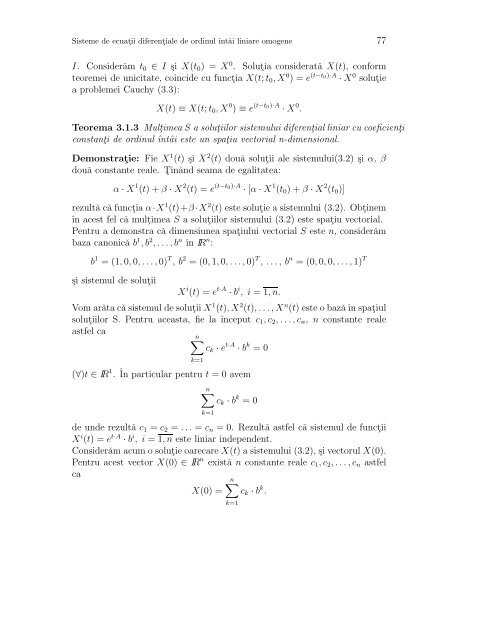Capitolul 1 Ecuatii diferentiale de ordinul ˆıntâi rezolvabile prin ...
Capitolul 1 Ecuatii diferentiale de ordinul ˆıntâi rezolvabile prin ...
Capitolul 1 Ecuatii diferentiale de ordinul ˆıntâi rezolvabile prin ...
You also want an ePaper? Increase the reach of your titles
YUMPU automatically turns print PDFs into web optimized ePapers that Google loves.
Sisteme <strong>de</strong> ecuat¸ii diferent¸iale <strong>de</strong> <strong>ordinul</strong> întâi liniare omogene 77<br />
I. Consi<strong>de</strong>rǎm t0 ∈ I ¸si X(t0) = X 0 . Solut¸ia consi<strong>de</strong>ratǎ X(t), conform<br />
teoremei <strong>de</strong> unicitate, coinci<strong>de</strong> cu funct¸ia X(t; t0, X 0 ) = e (t−t0)·A · X 0 solut¸ie<br />
a problemei Cauchy (3.3):<br />
X(t) ≡ X(t; t0, X 0 ) ≡ e (t−t0)·A · X 0 .<br />
Teorema 3.1.3 Mult¸imea S a solut¸iilor sistemului diferent¸ial liniar cu coeficient¸i<br />
constant¸i <strong>de</strong> <strong>ordinul</strong> întâi este un spat¸iu vectorial n-dimensional.<br />
Demonstrat¸ie: Fie X 1 (t) ¸si X 2 (t) douǎ solut¸ii ale sistemului(3.2) ¸si α, β<br />
douǎ constante reale. T¸inând seama <strong>de</strong> egalitatea:<br />
α · X 1 (t) + β · X 2 (t) = e (t−t0)·A · [α · X 1 (t0) + β · X 2 (t0)]<br />
rezultǎ cǎ funct¸ia α·X 1 (t)+β ·X 2 (t) este solut¸ie a sistemului (3.2). Obt¸inem<br />
în acest fel cǎ mult¸imea S a solut¸iilor sistemului (3.2) este spat¸iu vectorial.<br />
Pentru a <strong>de</strong>monstra cǎ dimensiunea spat¸iului vectorial S este n, consi<strong>de</strong>rǎm<br />
baza canonicǎ b 1 , b 2 , . . .,b n în IR n :<br />
b 1 = (1, 0, 0, . . ., 0) T , b 2 = (0, 1, 0, . . ., 0) T , . . ., b n = (0, 0, 0, . . ., 1) T<br />
¸si sistemul <strong>de</strong> solut¸ii<br />
X i (t) = e t·A · b i , i = 1, n.<br />
Vom arǎta cǎ sistemul <strong>de</strong> solut¸ii X 1 (t), X 2 (t), . . .,X n (t) este o bazǎ în spat¸iul<br />
solut¸iilor S. Pentru aceasta, fie la început c1, c2, . . ., cn, n constante reale<br />
astfel ca<br />
(∀)t ∈ IR 1 .<br />
n<br />
k=1<br />
ck · e t·A · b k = 0<br />
În particular pentru t = 0 avem<br />
n<br />
k=1<br />
ck · b k = 0<br />
<strong>de</strong> un<strong>de</strong> rezultǎ c1 = c2 = . . . = cn = 0. Rezultǎ astfel cǎ sistemul <strong>de</strong> funct¸ii<br />
X i (t) = e t·A · b i , i = 1, n este liniar in<strong>de</strong>pen<strong>de</strong>nt.<br />
Consi<strong>de</strong>rǎm acum o solut¸ie oarecare X(t) a sistemului (3.2), ¸si vectorul X(0).<br />
Pentru acest vector X(0) ∈ IR n existǎ n constante reale c1, c2, . . .,cn astfel<br />
ca<br />
X(0) =<br />
n<br />
k=1<br />
ck · b k .


